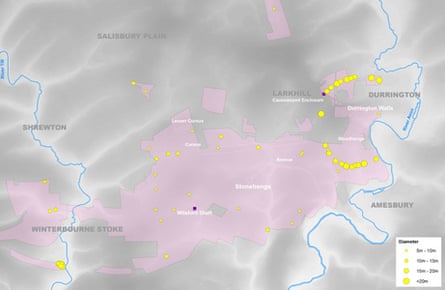The presence of an unusual circle of gaping pits, created by Neolithic people, near Stonehenge has been proven thanks to a new combination of scientific methods, says a team of archaeologists.
The architects of Stonehenge may have had the heavens in mind when they built the huge stone monument in Wiltshire, but the team believes the creators of Durrington's Pit were more interested in the underworld.
The Darrington Circle is thought to be a band of about 20 pits over a mile in diameter, with the Neolithic walls of Durrington and the Woodhenge sites at its centre.
Some of the holes are thought to be 10 meters wide and 5 meters deep, and digging them into the chalk landscape would require determination and engineering skills.
The apparent existence of the pit was first reported in 2020, with some describing it as largest prehistoric structure ever found in Britain.
Its discovery was also heralded as possible early evidence of numerical counting, as the large size of the circle meant that its creators had to somehow keep track of their position—the structure is too large to be created visually.
However, there was also skepticism, with some experts suggesting that the pits may have been natural objects rather than carved out by humans more than 4,000 years ago.
An article published in the journal Internet Archeology entitled Dangers of pits details the work done since then and concludes that they were made by humans.
Professor Vincent Gaffney from the School of Archaeological and Forensic Sciences University of Bradfordwho is leading the analysis, said he believed the new study showed the pits formed an “extraordinary structure.”
Gaffney said they used a combination of techniques that had never been used in this way before. “The exceptional size of the pits required a new strategy to explore them without the need for large and very expensive excavations,” he said.
“Because no single technology can answer all questions, several types of geophysical equipment were used to determine the size and shape of the pits.”

Electrical tomography assessed the depth of the pits, and radar and magnetometric tomography assessed their shape. But that didn't prove they were man-made, so sediment cores were extracted and a range of techniques were applied to them, including optically stimulated luminescence, which dates soil directly to the time it was last exposed to the sun, and “sedDNA”, which extracts animal and plant DNA from soil.
Researchers have found repeating patterns in the soil from different parts of the large object, which they say proves humans may have been involved. “They can't occur naturally. It just can't happen,” Gaffney said. “We think we've succeeded.”
The team believes the pits may have been dug during the late Neolithic period. Why will likely never be known, but Gaffney speculated that it may have had to do with belief in an underworld.
He said: “Now that we are sure the pits are a structure, we have a massive monument recording the cosmology of the people of that time on earth in a way we have not seen before. If this happens anywhere in Britain, it will happen at Stonehenge.”








